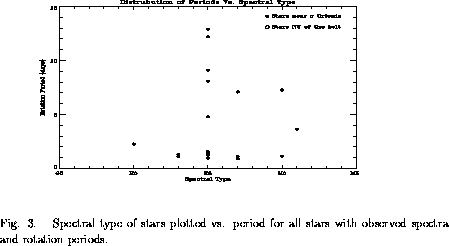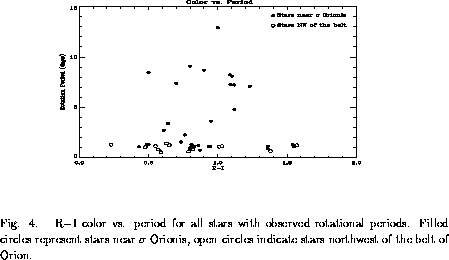


Next: Evolutionary Effects
Up: Discussion
Previous: Biases
Mindful of these biases, I can now explore the relations between the
measured rotation periods and various other observables.
The hypothesis behind
monitoring stellar variability is that active stars have asymmetric spot
distributions on their photospheres. It has been argued (Bouvier
1990) that if the magnetic field is a function of a dynamo, then the
faster rotators should be more active. Taking this to its logical
extension, the
stronger the activity, the greater the spot coverage, and thus the
stronger the observed variability should be, so long as the spot
filling factor does not exceed 50%. Choi & Herbst (1996) were
surprised to note the opposite effect. They found that only
stars with rotation periods greater than seven days show variations
greater than 0.4 magnitudes at I. Bouvier et al. (1995) found that
wTTs they observed did not vary by more
than half a magnitude in B or V while the cTTs varied by over a magnitude.
In Figure 2, a plot of rotation period versus
observed variability is shown. V--band is plotted because of its
greater sensitivity to spots. Almost 30% of the slow rotators show
variability of greater than 0.4 magnitudes at V-band,
while only 2 rapidly rotating stars
show such variability. Both of those stars had very high FAPs.
Overall, the mean value of the V-band modulation of the stars with
rotation periods < 4 days is 0.14 0.11 magnitudes,
while the modulation for the slower rotators is 0.32
0.11 magnitudes,
while the modulation for the slower rotators is 0.32 0.18
magnitudes. If I assume that the stars which are more slowly rotating
still have or recently lost their disks, the trend in these results,
while not as strong, is in agreement with analysis of
Herbst et al. (1994). Among PMS stars without disks, they found that
the observed variability had a mean of 0.32
0.18
magnitudes. If I assume that the stars which are more slowly rotating
still have or recently lost their disks, the trend in these results,
while not as strong, is in agreement with analysis of
Herbst et al. (1994). Among PMS stars without disks, they found that
the observed variability had a mean of 0.32 0.2 magnitudes in the
V-band. They find the cTTs with larger
amplitude variations, a mean 0.89
0.2 magnitudes in the
V-band. They find the cTTs with larger
amplitude variations, a mean 0.89 0.66 magnitudes.
0.66 magnitudes.

I did not observe objects as variable as those in the study of Herbst
et al. (1994). This may be due to selection effects. The optical
sources of variability on cTTs seem to be related to the disk and
accretion (Herbst et al. 1994).
X--ray selection not only selects out the most X--ray active
stars, it also singles out the more massive, G and K stars, ignoring
the M stars. Prosser et al.
(1993a) demonstrated a relation between X--ray flux and spectral
type in ZAMS stars. As shown in Figure 3, this dependence
does not translate itself
into a simple relation between rotation period and spectral type for
the PMS stars. Since
spectral data for most of the stars with rotation periods are not available,
R-I
color was taken to be a proxy for spectral type
(Figure 4). R-I color
was chosen since it was available for all stars and it is
least affected by both
from reddening extinction effects (which attenuate blue wavelengths more
strongly than red wavelengths) and by confusion caused by an active
chromosphere (which is a high temperature effect and thus is more
apparent in blue wavelengths). There is no apparent
direct relation between rotation and spectral type.


That the highest mass stars are rotating most
quickly may be an evolutionary effect. Such stars evolve more
quickly than low mass stars. Thus, they may lose their disks more
quickly, so that there are no slowly rotating high mass stars left to
observe by the age of Orion OB1b. However,
Figure 4 does not confirm this.
The bias towards monitoring only X--ray
active sources confuses any possible interpretation.
Note that in the Pleiades,
while stars later than about K0 appear to have saturated X--ray
luminosities, in earlier types the relative X--ray luminosity decreases
as mass increases (Prosser et al. 1993).
In Orion OB1a and b, the most evolved of these stars are starting on their
radiative tracks, so they are no longer fully convective.



Next: Evolutionary Effects
Up: Discussion
Previous: Biases
Scott J. Wolk
Thu Dec 5 15:48:37 EST 1996
 0.11 magnitudes,
while the modulation for the slower rotators is 0.32
0.11 magnitudes,
while the modulation for the slower rotators is 0.32 0.18
magnitudes. If I assume that the stars which are more slowly rotating
still have or recently lost their disks, the trend in these results,
while not as strong, is in agreement with analysis of
Herbst et al. (1994). Among PMS stars without disks, they found that
the observed variability had a mean of 0.32
0.18
magnitudes. If I assume that the stars which are more slowly rotating
still have or recently lost their disks, the trend in these results,
while not as strong, is in agreement with analysis of
Herbst et al. (1994). Among PMS stars without disks, they found that
the observed variability had a mean of 0.32 0.2 magnitudes in the
V-band. They find the cTTs with larger
amplitude variations, a mean 0.89
0.2 magnitudes in the
V-band. They find the cTTs with larger
amplitude variations, a mean 0.89 0.66 magnitudes.
0.66 magnitudes.


